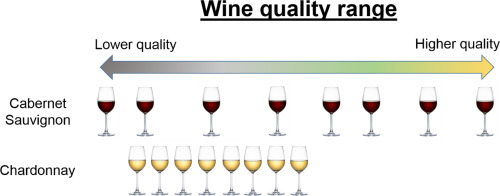Food Research International ( IF 7.0 ) Pub Date : 2017-12-26 , DOI: 10.1016/j.foodres.2017.12.060 Jun Niimi , Paul K. Boss , Susan E.P. Bastian

|
The sensory profiles of Cabernet Sauvignon and Chardonnay research wines were determined and analysed together with wine quality scores of expert judges. Research Cabernet Sauvignon and Chardonnay wines from three and two vintages, respectively, were evaluated. Wines of both varieties were produced with grapes harvested from across South Australian wine making regions throughout 2013–2016 vintages. Wines within varieties were vinified identically across samples and also across vintages. Wines were profiled in triplicate using descriptive analysis with a panel of trained assessors (n = 9–11) and graded for quality in triplicate by winemakers (n = 6–9) using a sorting task based on similarity of quality and with the aid of definitions formed by the winemakers prior to sorting. The data sets were analysed using canonical variate analysis (CVA) and multidimensional scaling (MDS). The scores from CVA and MDS per variety per vintage were analysed using Generalised Procrustes Analysis (GPA). Differences in Cabernet Sauvignon samples by provenance were determined, where associations with regions by sensory attributes were observed in all vintages. These wines were consistently sorted based on quality by the winemakers, evident from GPA. Chardonnay in comparison were poorly discriminated in both sensory profiles and quality. The combination of descriptive sensory analysis with sorting was complimentary to each other and was able to uncover additional information about the sensory properties of wines when the two methods were used in concert, such as balance and complexity. However the red wine variety had more intrinsic characteristics that lead to better discrimination based on sensory properties and hence quality than the white wine variety.
中文翻译:

研究赤霞珠和霞多丽葡萄酒的感官特征和质量评估;质量歧视取决于多种模式的更大差异
确定和分析赤霞珠和霞多丽研究用酒的感官特征,以及专家评审的葡萄酒质量得分。对分别来自三个和两个年份的赤霞珠和霞多丽葡萄酒进行了评估。在2013-2016年的整个年份中,这两个品种的葡萄酒都是使用从南澳大利亚州各个酿酒区收获的葡萄生产的。不同品种和年份的葡萄酒在品种上都完全相同。通过由一组训练有素的评估员(n = 9-11)进行的描述性分析,对葡萄酒进行了三次重复分析,然后酿酒师(n = 6-9)对葡萄酒进行了三次重复质量分级,该任务基于质量相似性并借助酿酒师在分选之前形成的定义。使用规范变量分析(CVA)和多维标度(MDS)分析数据集。每个葡萄品种在每个年份的CVA和MDS得分均使用广义Procrustes分析(GPA)进行了分析。确定了赤霞珠样品在出处上的差异,在所有年份中均通过感官属性与区域相关联。这些葡萄酒由酿酒师根据质量始终如一地进行分类,从GPA可以明显看出。相比之下,霞多丽在感官特征和质量上都难以区分。描述性感官分析与分选相结合是相辅相成的,当两种方法共同使用时,能够发现有关葡萄酒感官特性的其他信息,例如平衡性和复杂性。









































 京公网安备 11010802027423号
京公网安备 11010802027423号